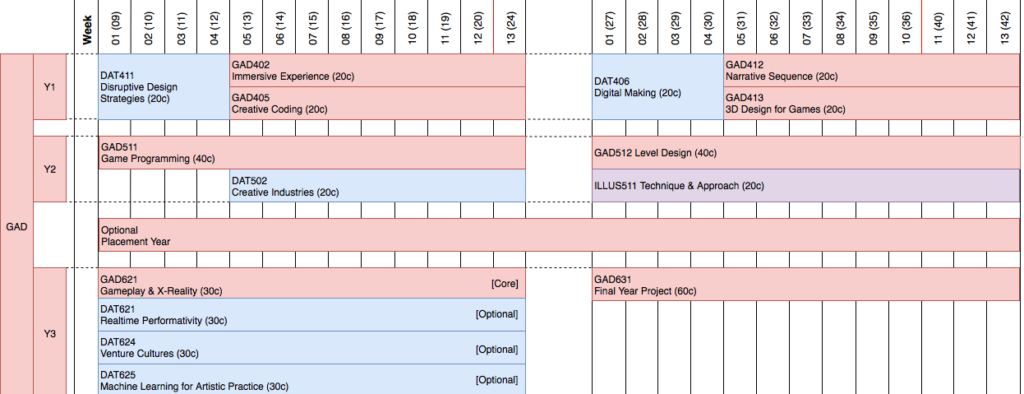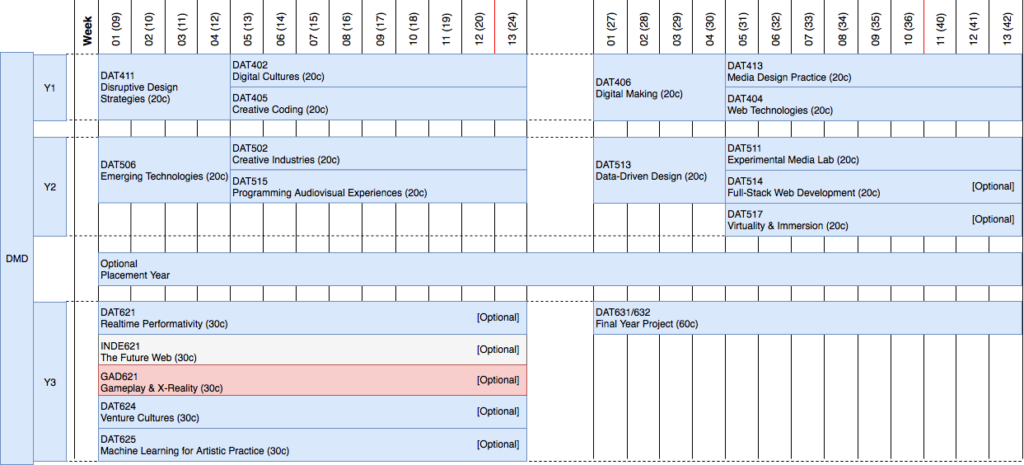Digital Media Design
From August 2017 till June 2019, I had the opportunity to be Associate Professor and Programme Leader in the Digital Media Design group (previously known as Digital Art & Technology), a cutting-edge cluster of courses in the School of Art, Design, and Architecture at the University of Plymouth. DMD offers 3 undergraduate courses with routes through to a taught (PGT) Masters programme, MRes Digital Art & Technology. It sits alongside the i-DAT Research Group, which delivers a Research Masters (PGR) ResM, and a Doctor of Philosophy (PhD) in Digital Art and Technology:
- BA/BSc Digital Media Design
- BA/BSc Internet Design
- BA Game Arts & Design
- MRes/ResM Digital Art & Technology
- Doctor of Philosophy (PhD) in Digital Art & Technology
Here follows a short introductory video for the undergraduate courses:
The programme provides a wide range of labs for the students to develop ground-breaking work in art, media, and technology. The facilities include a 36-sitting Dome environment, a MakerSpace (with a large range of assorted electronics, sensors, computers), a Prototyping Lab, a Digital Fabrication Suite, a range of Media Design Labs (equipped for video, image, sound editing and pre and post production), and access to the new Immersive Studios of the School.
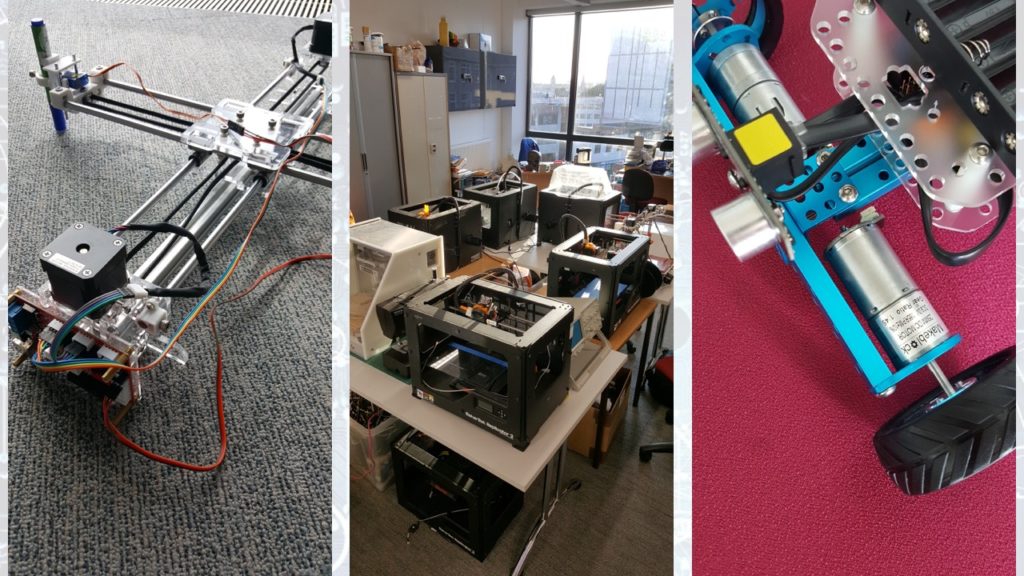
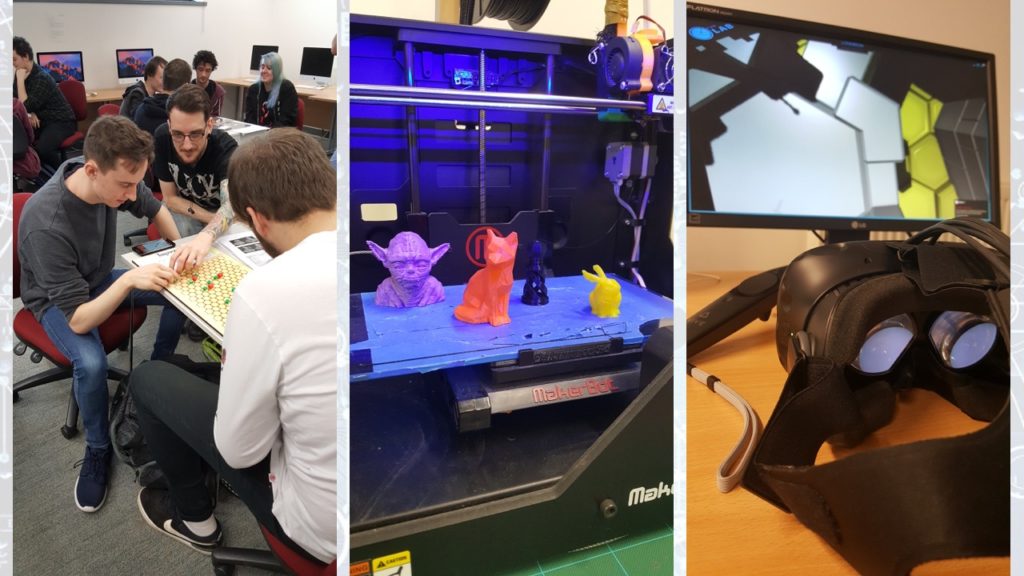
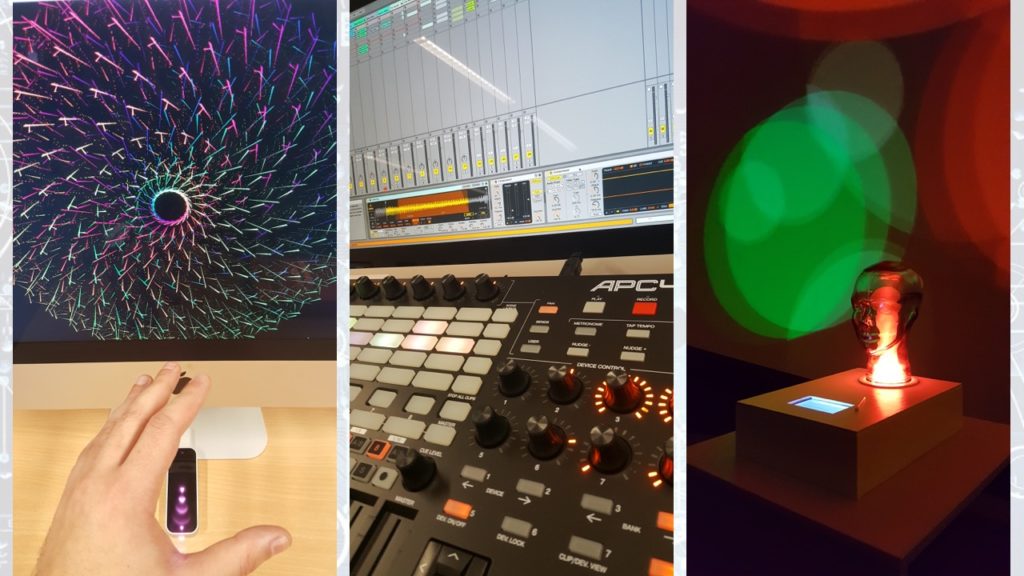
As the programme covers a wide range of areas, students’ outcomes vary; machine learning, interaction design, AR/VR, game design, web development, and media art, are a few topics that students specialise in:
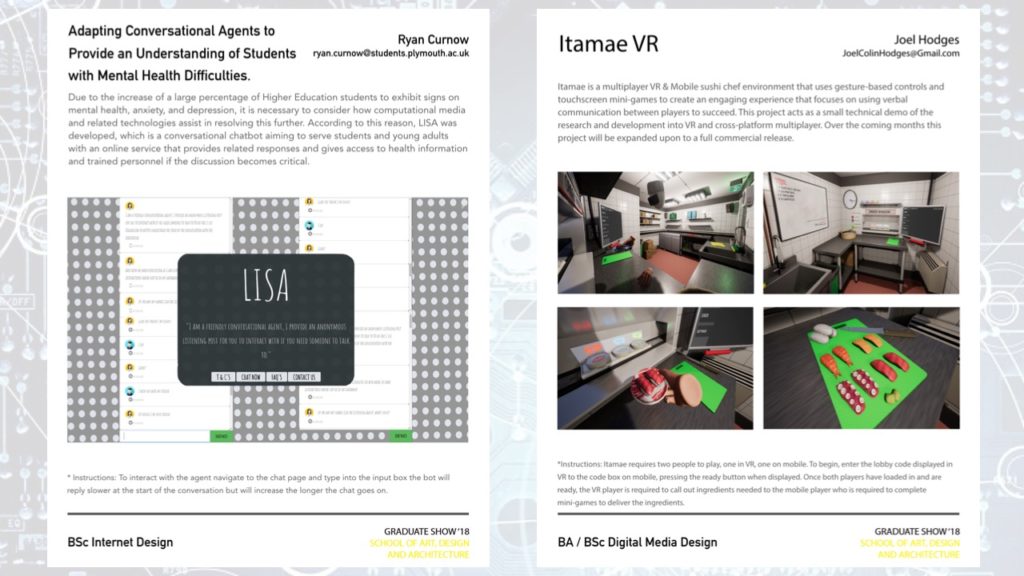
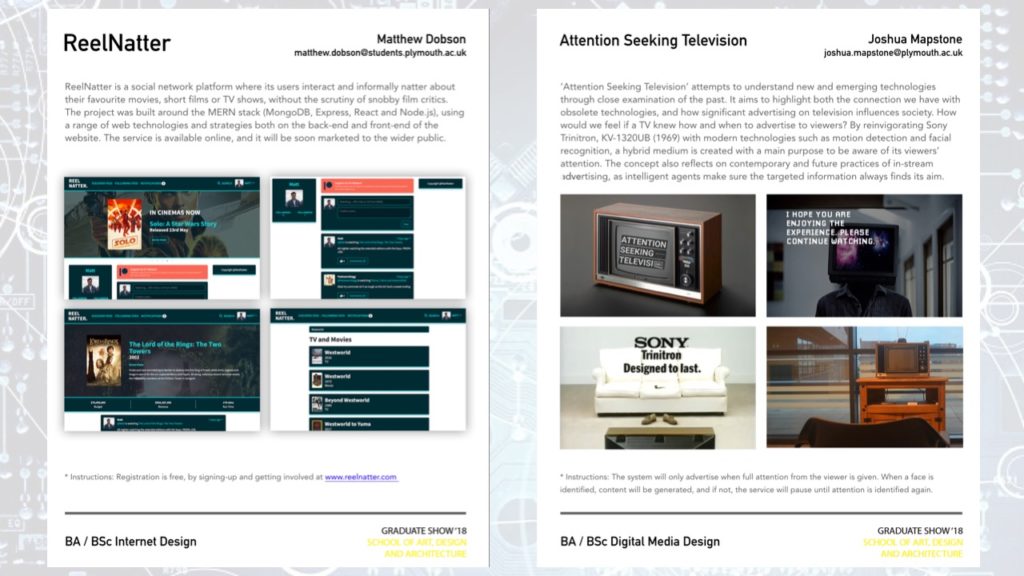
Below follow additional students’ projects:
Duties & Responsibilities
My responsibilities in the programme included the main management of operation of all courses, to provide main guidelines to lectures, teaching, and technical staff, be responsible for the full administrational functionality of the programme, budgeting and purchases, hiring of new full-time and part-time staff (according to business demands), and ensuring that all students, courses, and staff are fully-equipped to produce academic duties that follow the vision of the cluster, which is directly informed from research and industrial directions.
For my teaching, I was responsible for the following modules/courses:
- DAT401 Strategies for Art and Technology (lecturer)
- INDE401 Strategies for Internet Design (module leader, lecturer)
- GAD401 Strategies for Game Arts and Design (lecturer)
- DAT405 Creative Coding (module leader, lecturer)
- INDE402 Datacloud (module leader, lecturer)
- GAD405 Creative Coding (module leader, lecturer)
- DAT504 Advanced Web Technologies (lecturer)
- DAT505 Advanced Creative Coding (module leader, lecturer)
- DAT503 Reflexive Design (module leader, lecturer)
- INDE502 Net Architectures (module leader, lecturer)
- DAT601 Everyware (module leader, lecturer)
- INDE601 Netscapes (module leader, lecturer)
- DAT611/612 Final Year Project (module leader, tutor)
- INDE611/612 Final Year Project (module leader, tutor)
- DAT613 Dissertation (tutor)
Programme Updates
For year 2019-2020, the curricula for the courses have been updated. Below follows a description of the new modules/courses that I designed for the DAT group and the University of Plymouth:
Programme Update for Academic Year 2019-2020
BA/BSc Digital Media Design, BA/BSc Internet Design, BA Game Arts and Design
YEAR 1
DAT411 Disruptive Design Strategies (S1, Core, 20 credits)
This module introduces students to practical and creative processes that encourage experimentation and foster critical thinking. Through conceptual understanding of artistic practice combined with technical production skills in a range of areas, such as 2D and 3D design, digital fabrication, and physical computing (electronics and micro-controllers), students are expected to develop physical prototypes and media outputs that demonstrate innovative thinking within a multi-disciplinary context. Induction is given to a fully-equipped maker space, digital fabrication suites, and a 360° Immersive Vision Theatre.
DAT402 Digital Cultures (S1, Core, 20 credits)
This module provides a comprehensive grounding to theoretical and practical contexts for contemporary digital media practice. It explores the history of new media and interactive art, highlighting connections between pre-digital technologies and contemporary media forms. Practical workshops to video and recording studios, moving image studio with green screen, access to still and moving image cameras, as well as a field trip to a relevant UK-based cultural centre, offer substantial resources to advance students’ work within digital and media culture.
INDE402 Datacloud (S1, Core, 20 credits)
In this module students are exposed to a wide variety of data sources ranging from classic databases, through web services to cloud data storage architectures. Students gain an understanding of the relative benefits and disadvantages of each technology and develop of knowledge of how to select an appropriate technology for a particular task.
GAD402 Immersive Experience (S1, Core, 20 credits)
This module introduces the techniques used to design and develop immersive experiences inside Unity game engine. Through development of a first-person exploration game, students learn the fundamentals of working within a professional game engine and level editor, such as cameras, lights, particle systems, physics, animation and audio. Students also learn to create their own 3D models in Maya, and are introduced to key game design concepts such as game feel and environmental storytelling.
DAT405 Creative Coding (S1, Core, 20 credits)
This module is an introduction to programming and creative coding for digital artists and designers. The syllabus, topics, examples and style of teaching are designed to support contemporary techniques for the development of engaging interactive media projects, with a focus on interaction, graphics, video, animation, sound, and integration with live data sources. During this module, students are asked to develop mini-projects that demonstrate their creativity and coding skills, and to produce a portfolio as a showcase exhibited on related online platforms.
GAD405 Creative Coding (S1, Core, 20 credits)
This module provides an introduction to coding for game designers, explored through the creation of a playful interactive project. Working with programming languages and game engines, students learn to use code to make their drawings and animations come to life with dynamic and interactive behaviours. Students develop a core of key programming concepts such as variables and conditional logic, and apply what they have learnt to solve problems and create engaging gameplay.
DAT406 Digital Making (S2, Core, 20 credits)
This module covers fundamental topics on digital making and physical computing, providing an opportunity to develop interactive systems with the use of electronics, sensors, and physical outputs – such as lights and speakers. Through a series of practical lab-based sessions, students get hands-on experience in implementing their own digital systems for creative practice and artistic expression. Full access is given to maker space and digital fabrication facilities, which include design and making tools, such as 3D printers, laser-cutters, and CNC routers.
DAT413 Media Design Practice (S2, Core, 20 credits)
This module offers 100% digital media design practice with contemporary tools that assist in developing engaging works in 2D, 3D, VFX, and animation formats. Design issues and technical production and distribution processes are investigated, combined with practical work with industry-standard software packages, such as Adobe Creative Cloud and Autodesk. Topics such as workflows, pipelines, assets, procedural creation, compositing, rendering, and more, are covered, providing rich content for producing professional media animations and motion graphics.
GAD413 3D Design for Games (S2, Core, 20 credits)
Students create character and environment concepts as digital paintings, and realise their designs as detailed 3D models. Drawing and painting skills are developed, exploring figure, proportion, lighting, colour and value. Students learn advanced modelling and texturing skills using state-of-the-art software platforms, rigging their characters for animation and exporting them to game engines. In addition, students develop presentation skills and showcase their work in a digital portfolio.
GAD412 Narrative Sequence (S2, Core, 20 credits)
In this module, students explore interactive storytelling and animation / sequence creation within games, and drawing on a range of traditional and digital media and formats. Storytelling, narrative pacing, sound design, creative writing and animation are features of this module. Students create a short game that tells a unique story.
DAT404 Web Technologies (S2, Core, 20 credits)
This module aims to present from a contextual and applied standpoint, key issues related to designing and publishing content for the web. Practical sessions ensure that students enhance their skills and abilities on identifying and implementing web solutions by utilizing emerging trends and industrial platforms – such as HTML, CSS, and JavaScript. Emphasis is placed on the development of creative web design for the production and programming of online media, investigating essential topics such as navigation, hyper-media, narrative, representation, games, and interactivity.
YEAR 2
DAT506 Emerging Technologies (S1, Core, 20 credits)
This module explores emerging trends and practices that influence the creative industries, digital media, and society. Students are introduced to a range of technologies and their applications in Artificial Intelligence and machine learning, blockchain, immersive media, interactive interfaces, robotics, the Internet of Things, and more. Through critical reflection, research methodologies, and hands-on practice, students are asked to study the implications of these technologies within their field of expertise, and to demonstrate their ideas on how to take advantage of these emerging trends for creative and artistic practice within digital media, web development, and game design.
DAT502 Creative Industries (S1, Core, 20 credits)
This module offers a comprehensive analysis of the contemporary creative industries, especially those linked directly to digital media, Internet technologies, and gaming. It explores the dynamic changes in key sectors that are brought about by the impact of new media technologies. Students in this module are engaged through group research and development projects to investigate the practical issues underpinning the management of distributed organisations, and to demonstrate an understanding in the operating practices for the production of innovative media products and services. During this module, industry experts are frequently invited to share valuable advice that further helps students build knowledge on their respective field.
INDE511 UI/UX Design (S1, Core, 20 credits)
This module provides students with an introduction to contemporary design processes from conception through development, to realisation. Supported by a critical examination of cultural artefacts, the module demands students to synthesise a design practice with an understanding of historical, human-centred, environmental and educational principles in the areas of UI (User Interface) and UX (User Experience).
DAT515 Programming Audiovisual Experiences (S1, Core, 20 credits)
The module addresses advanced topics in programming for digital artists and designers. This includes coverage of a range of development practices including generative art, visualization/sonification and interaction techniques, advanced algorithms for animation, APIs and open data services, as well as WebGL, WebAudio and WebVR frameworks. The module expects students to engage with programming and media design practices in creating professional interactive audiovisual compositions.
GAD511 Game Programming (S1, Core, 20 credits)
This module builds on the game programming skills developed to this point, and applies them to working with a range of different game genres. Students explore first-person shooters, 3rd-person adventures, driving games, 2D platformers and arcade shoot ‘em ups. Working individually, they choose two of these genres and produce games that demonstrates the application of animation, physics, trigonometry, artificial intelligence, user interface, and game state management.
GAD502 Level Design (S1, Core, 40 credits)
This module focuses on designing virtual environments and game levels. Students will consider the ludic and narrative role of level design and apply these to the production of an interactive game environment. Students will be presented with a variety of theoretical frameworks that will help them better understand human cognitive processes and thus aid them in designing and creating more engaging game levels. Automated procedural generation will also be explored.
DAT513 Data-Driven Design (S2, Core, 20 credits)
This module aims to inform and equip students with computational media and data-driven design skills, highlighting their importance and implications on a wide range of practices and applications within contemporary media environments and industries. Students get to develop from conception through development, to realisation, their own physical and digital prototypes with creative coding, data visualization, locative media, augmented reality, and human-computer interaction. In addition, the module introduces students to the Internet of Things and related systems and technologies, including the IBM Cloud and Bluemix.
DAT511 Experimental Media Lab (S2, Core, 20 credits)
This module offers 100% production skills in developing digital media artworks for the year exhibition. Students have hands-on experience with computational media and experimental technologies, which help them to produce innovative interactive content. With the guidance of the teaching staff, the students enhance their creative methodologies and critical understanding of their work situated within contemporary art and media contexts. For the needs of this module students have full access to a maker space with state-of-the-art prototyping resources, digital fabrication facilities, as well as a 360° Immersive Vision Theatre.
DAT517 Virtuality and Immersion (S2, Optional, 20 credits)
This module provides a firm introduction to virtuality and immersion – augmented reality, virtual reality, and dome environments. During this module, students explore and utilize a range of immersive technologies and design practices on subjects such as scientific simulation, virtual heritage, architectural visualization, and more. Techniques like 3D capture and photogrammetry are also introduced, and a range of resources are provided, such as AR and VR headsets, for developing complete immersive solutions, applications, and artworks. The module is optional, and it is recommended for students that are interested in pursuing specialization on immersive media.
DAT514 Full-Stack Web Development (S2, Optional, 20 credits)
The module equips students with practical skills on “full-stack” development, creating content for high-end architectures for web applications, utilizing clients, servers, and databases. Students are expected to use appropriate tools and programming languages, test and debug their applications, use tools for version control, and apply their skills and knowledge to design, develop and deploy a web application of professional quality. The module is optional, and it is recommended for students that are interested in pursuing specialization on web development.
YEAR 3
DAT621 Realtime Performativity (S1, Optional, 30 credits)
This module offers students technical and conceptual skills to experiment and innovate with live media systems, immersive 2D and 3D media, interactive computing and audiovisual technologies (sound, moving image, visualizations), and to develop technically, aesthetically and conceptually sophisticated applications, performances, or installations. In workshops, seminars and live projects, students create works informed by experimental approaches to audiovisual computing practices in a variety of artistic, cultural and industrial contexts. Outputs of this module are expected to be of a professional quality that appears in festivals, exhibitions, and related cultural events. The module is optional, and it is recommended for students that are interested in pursuing specialization on interactive art and media design.
INDE621 The Future Web (S1, Optional, 30 credits)
This module prepares students for the future of web and Internet systems by introducing them to state-of-the-art and currently emerging technologies in this area, with an aim to develop practical and theoretical techniques that inform the production of complex web systems. The module makes extensive use of the IBM WebSphere and its applications on the Smarter Planet initiative, which presents innovative solutions for industries, cities, and whole societies by utilizing intelligent connectivity, cognitive computing applications, automation, and optimized data-driven systems. The module is optional, and it is recommended for students that are interested in pursuing specialization on web development.
GAD621 Gameplay & X-Reality (S1, Optional, 30 credits)
This module explores contemporary frameworks for gameplay and virtual environments (AR, VR, XR), with a focus on production methodologies and the broader field of “play” within a creative and technological context. It provides a grounding in relevant cultural, social, psychological, and economic theories, as well as strategies for synthesis of design and production of experimental prototypes. Practical workshops cover game development platforms (3D modelling and animation, game engines, motion capture systems), as well as speculative and emerging environments for AR/VR/XR development, including headsets, tracking technologies, and sensory-based systems. The module is optional, and it is recommended for students that are interested in pursuing specialization on game design and immersive media.
DAT604 Venture Cultures (S1, Optional, 30 credits)
This module introduces students to the concepts of entrepreneurship through the practical exploration of individual, collaborative and organisational creative enterprise. Operating as a pragmatic vehicle for generating new ventures within the creative industries, the formation of prototype companies enables students to rehearse the commercialisation of their practice. By the end of this module, students have in place a business plan for a startup company of a digital product or service related to their field of expertise, i.e. interactive design, web development, immersive media, gaming, Internet of Things, etc. Industry experts are invited frequently to provide guidance for the students’ projects, and to give valuable advice and feedback for the final project outcomes. The module is optional.
DAT625 Machine Learning for Artistic Practice (S1, Optional, 30 credits)
This module covers machine learning and its applications within the areas of digital media, such as big data and visualization, automation, conversational agents, and voice, face, and sentiment recognition systems. The students are given a comprehensive historical overview of “intelligent” computational agents, from cybernetics to DeepMind, Microsoft Cognitive Toolkit, Baidu AI, and IBM Watson, and they focus on understanding and implementing contemporary development practices in machine learning and Artificial Intelligence, with an emphasis on creative applications for artistic practice. The module is optional, and it is recommended for students that are interested in pursuing a BSc degree and a specialization on information design.
DAT631/DAT632/INDE631/GAD631 Final Year Project (S2, Core, 60 credits)
The Final Year Project is student-led, negotiated through close liaison with an allocated supervisor. Students are expected to develop a creative, practical industry-standard project, accompanied with a written work that demonstrates sophisticated research methods, a critical engagement to theoretical discourses and debates, an understanding of production processes, and a developed awareness of markets, audiences, and industrial contexts. The practical element needs to comprise of a significant digital media production that is innovative and experimental in its approach and placed within a contemporary framework. Resources such as software, hardware, and labs, as well as tutorials in research and writing are given to the students to ensure they are fully-equipped to produce a sophisticated result. The final works are exhibited on the Degree Show at the end of the school year.
BA/BSc Digital Media Design (Diagram 2019-2020)
BA/BSc Internet Design (Diagram 2019-2020)
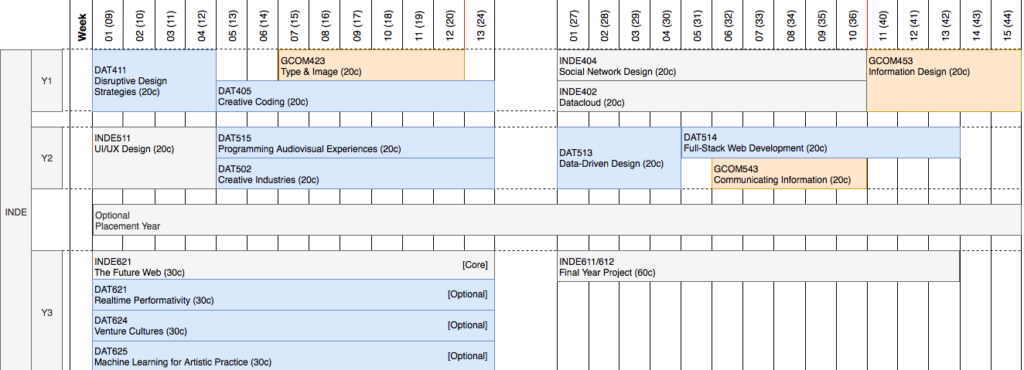
BA Game Arts and Design (Diagram 2019-2020)
